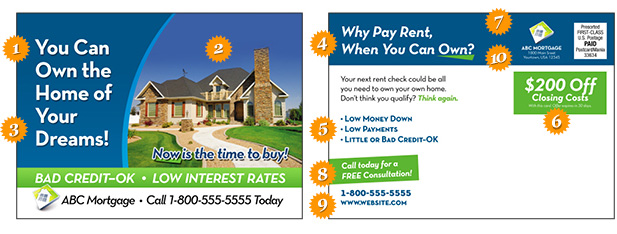
A picture may be worth a thousand words, but an effective postcard design is worth a thousand prospects.
The design of your postcard is almost as important in eliciting a response as getting a good list – it runs a very close second. Much as in deciding on a list, there are definite rules you should follow when designing a postcard.
Based on what I said earlier about the quantity of mail determining your income, you could literally slap together a postcard on your own printer, send it out consistently, and still make money. However, there is more to direct mail marketing than the bare minimum, and eventually low quality will start to affect your campaign. Since you are reading this book, I take it that you want to know how you can utilize direct mail to really grow your company. And that requires far from the bare minimum.
Do you want your direct mail postcard to end up in the trash with the rest of the unread mail? Studies show an effective direct mail campaign should generally draw a .5 to 1 percent response – but this depends on the industry. The percentage could be more.
These are the 10 elements your design absolutely must have to maximize your return:

- A clear, bold headline.
On the postcard there should be one central message. The best way to achieve that is with a bold, clear headline that isn’t cluttered up with other text. The headline should allow the recipient to immediately know what you’re selling. - A graphic that supports the message.
The graphic should be easy to understand and add to the message the headline is conveying. For instance, if you are trying to get people to list their home, you would want to show a home with a SOLD sign clearly visible out front. That graphic reinforces the message more than a plain picture of a home. - Color that pops.
Make the headline and other text stick out by using a color that stands out from the background color. When you look at the card, ask yourself, “What do I see first?” If it isn’t the headline, you might want to tweak the colors. - Subheads that lead into text.
If you have a couple paragraphs of text with no lead in on the back of your postcard, there’s nothing to entice people to read the copy. A subhead will give prospects a place to start reading. If you have only a hundred words or so, you may be able to get away with it, but if the text gets any longer the average reader will need some guideposts along the way. - Benefits, benefits, benefits.
One of the biggest errors people make in advertising is stating features, rather than benefits. For example, never assume recipients know what benefit can be derived from a lower interest rate on their mortgage. Instead, let them know their monthly payments will go down. - The offer.
An offer is always a good idea and should represent a specific reason to call NOW, such as “Limited supply” or “Interest rates are climbing,” or “Save $50 before the end of the month.” - Your company name and logo.
Although this needs to be on the mailer, it shouldn’t overshadow the offer. Customers care most about what you can do for them – not who you are or how great you say you are. - Call to action.
Tell prospects exactly what you want them to do. “Call today for more information” or “See us online” are two of the most common desired actions. - Contact information.
Provide your name, phone number, and web address directly following the call to action. Whatever you ask prospects to do, give them the means to do it – right away. - Return address.
A return address ensures you’ll get returned mail from the post office and communicates you’re an established professional. People feel better knowing the company they’re dealing with has an actual location.
Start Planning Your Own Marketing Campaign!



